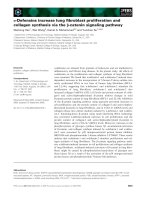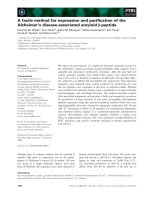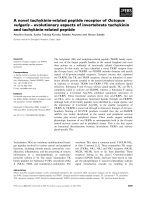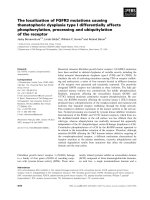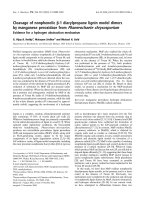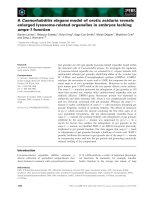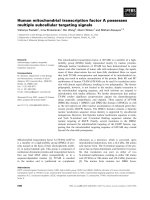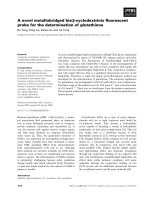Báo cáo khoa học: A mitochondrial cytochrome b mutation causing severe respiratory chain enzyme deficiency in humans and yeast doc
Bạn đang xem bản rút gọn của tài liệu. Xem và tải ngay bản đầy đủ của tài liệu tại đây (338.26 KB, 10 trang )
A mitochondrial cytochrome b mutation causing severe
respiratory chain enzyme deficiency in humans and yeast
Emma L. Blakely
1
, Anna L. Mitchell
1
, Nicholas Fisher
2
, Brigitte Meunier
2
, Leo G. Nijtmans
3
,
Andrew M. Schaefer
1
, Margaret J. Jackson
4
, Douglass M. Turnbull
1
and Robert W. Taylor
1
1 Mitochondrial Research Group, School of Neurology, Neurobiology and Psychiatry, The Medical School, University of Newcastle upon
Tyne, UK
2 Wolfson Institute for Biomedical Research, University College London, UK
3 Nijmegen Center for Mitochondrial Disorders, Department of Pediatrics, Radboud University Nijmegen Medical Center, the Netherlands
4 Department of Neurology, Royal Victoria Infirmary, Newcastle upon Tyne, UK
The mitochondrial bc
1
complex (ubiquinol–cytochrome
c oxidoreductase or complex III; EC 1.10.2.2) is a
membrane-bound enzyme that catalyses the transfer of
electrons from ubiquinol to cytochrome c, coupling
this process to the translocation of protons across the
inner mitochondrial membrane. In higher eukaryotes,
the enzyme complex is composed of 11 polypeptide
subunits. One subunit, cytochrome b, is encoded
by the mitochondrial genome (mtDNA) [1] whilst the
others are encoded by the nucleus and synthesized on
cytoplasmic ribosomes prior to being imported into
mitochondria and assembled into a functional com-
plex. As a hydrophobic, integral membrane protein
consisting of eight transmembrane helices, cyto-
chrome b is fundamental for the assembly and function
of complex III, and together with cytochrome c
1
and
the iron–sulfur protein (ISP) it forms the catalytic core
of the enzyme.
It has become apparent in recent years that dis-
orders of the mitochondrial respiratory chain due to
Keywords
Mitochondrial DNA (mtDNA); complex III;
complex I; cytochrome b; yeast mutants
Correspondence
R.W. Taylor, Mitochondrial Research Group,
School of Neurology, Neurobiology and
Psychiatry, The Medical School, Framlington
Place, University of Newcastle upon Tyne,
NE2 4HH, UK
Fax: +44 191 2228553
Tel: +44 191 2223685
E-mail:
(Received 15 April 2005, accepted 19 May
2005)
doi:10.1111/j.1742-4658.2005.04779.x
Whereas the majority of disease-related mitochondrial DNA mutations
exhibit significant biochemical and clinical heterogeneity, mutations within
the mitochondrially encoded human cytochrome b gene (MTCYB) are
almost exclusively associated with isolated complex III deficiency in muscle
and a clinical presentation involving exercise intolerance. Recent studies
have shown that a small number of MTCYB mutations are associated with
a combined enzyme complex defect involving both complexes I and III, on
account of the fact that an absence of assembled complex III results in a
dramatic loss of complex I, confirming a structural dependence between
these two complexes. We present the biochemical and molecular genetic
studies of a patient with both muscle and brain involvement and a severe
reduction in the activities of both complexes I and III in skeletal muscle
due to a novel mutation in the MTCYB gene that predicts the substitution
(Arg318Pro) of a highly conserved amino acid. Consistent with the dra-
matic biochemical defect, Western blotting and BN-PAGE experiments
demonstrated loss of assembled complex I and III subunits. Biochemical
studies of the equivalent amino-acid substitution (Lys319Pro) in the yeast
enzyme showed a loss of enzyme activity and decrease in the steady-state
level of bc
1
complex in the mutant confirming pathogenicity.
Abbreviations
BN-PAGE, Blue-native PAGE; ISP, iron–sulfur protein; MELAS, mitochondrial encephalopathy, myopathy, lactic acidosis and stroke-like
episodes; MERRF, myoclonic epilepsy and ragged-red fibres; MTCYB, mitochondrial cytochrome b gene; mtDNA, mitochondrial DNA;
MRI, magnetic resonance imaging; Q
o
, quinol oxidation site; Q
i
, quinol reduction site; RFLP, restriction fragment length polymorphism;
RRF, ragged-red fibre.
FEBS Journal 272 (2005) 3583–3592 ª 2005 FEBS 3583
pathogenic mutations in mtDNA genes are amongst
the most common inherited human metabolic diseases
[2]. Many pathogenic mtDNA mutations are hetero-
plasmic, affecting a population of mitochondrial
genomes within the cell, and all cause disease by a
common mechanism, the impairment of cellular oxida-
tive phosphorylation [3]. Patients can present with a
wide spectrum of clinical phenotypes affecting predo-
minantly skeletal muscle, heart and the CNS, which is
dependent upon the abundance and segregation of
the causative mutation, the gene that is mutated and
the associated biochemical defect; point mutations in
mitochondrial tRNA genes and large-scale mtDNA
rearrangements cause multiple respiratory chain abnor-
malities through impairment of mitochondrial trans-
lation [4], whilst mutations in protein-coding genes
generally affect only a single enzyme complex [5,6].
A number of patients with respiratory complex III
deficiency due to nonsense, missense or frameshift
mutations in the cytochrome b (MTCYB) gene have
now been described [7]. Although MTCYB mutations
are associated with numerous clinical presentations
including mitochondrial encephalopathy [8,9], cardio-
myopathy [10,11], septo-optic dysplasia [12] and a
multisystem disorder [13], the overwhelming majority
have been reported in patients with severe exercise
intolerance and myopathy, often associated with mus-
cle weakness and ⁄ or myoglobinuria and evidence of
mitochondrial proliferation as evidenced by ragged-red
fibres (RRF) on muscle biopsy [14–20]. In many of
these patients the genetic defect arises sporadically,
does not appear to be transmitted to offspring and is
restricted to skeletal muscle with no evidence of the
mutation in mitotic tissues such as peripheral lympho-
cytes. Although this absence of pathogenic mutations
in fibroblasts and platelets precludes their study in
transmitochondrial cybrid cell lines, significant insight
into the underlying molecular mechanism of human
MTCYB mutations has been made by introducing
the equivalent amino-acid substitutions into the yeast
(Saccharomyces cerevisiae) enzyme [21,22].
A curious observation in some patients with
MTCYB mutations is that whilst the genetic defect
resides within a structural component of complex III,
the in vitro assay of respiratory chain enzyme activities
in muscle mitochondria reveals deficiency of both
complexes I (NADH–ubiquinone oxidoreductase) and
complex III [16,18,19]. Conversely, mutation of the
nuclear encoded complex I gene NDUFS4 also results
in a reduction of complex III activity in addition to
complex I deficiency [23]. Recent studies using both
human and mouse cell lines harbouring deleterious
MTCYB mutations have demonstrated a structural
dependence among complexes I and III, highlighting
the need for a fully assembled respiratory complex III
for the stability and activity of complex I [24]. Further-
more, these experiments corroborate previous two-
dimensional blue native electrophoresis data which
revealed that individual respiratory chain complexes
physically interact with each other to form supercom-
plexes [25].
Here we report our studies in a patient with mito-
chondrial encephalopathy and a previously unreported
15 699 GfiC MTCYB mutation that predicts a highly
conserved amino-acid substitution (Arg318Pro) in the
C-terminal portion of the protein. In agreement with
recent findings, analysis of the patient’s muscle biopsy
reveals a severe biochemical deficiency in the activities
of both complex III and complex I which is reflected
by a dramatic loss in the steady state levels of both
complexes, whilst modelling of the equivalent mutation
in yeast (Lys319Pro) reveals a bc
1
defect, thus confirm-
ing the pathogenicity of the human 15 699 GfiC
mtDNA transversion.
Results
Biochemical analysis of patient’s muscle biopsy
reveals a combined deficiency of complexes I
and III
Enzyme histochemistry of the patient’s muscle revealed
normal activities of both cytochrome c oxidase (COX)
and succinate dehydrogenase, although approximately
1% of total fibres showed evidence of subsarcolemmal
accumulation of mitochondria, typical of ragged-red
fibres. Measurements of the individual respiratory
chain complexes in patient muscle mitochondria
revealed specific defects involving complexes I and III
activities (Table 1), both of which were decreased to
approximately 5% of control values. Furthermore, the
activities of these enzymes and other respiratory chain
complexes were entirely normal in muscle from both
the patient’s clinically unaffected mother and her sister
(Table 1).
Mitochondrial DNA analysis identifies a novel
MTCYB mutation
The patient’s clinical presentation, together with the
histochemical and biochemical findings in muscle,
prompted us to pursue a mitochondrial genetic abnor-
mality. Following a negative screen for common
pathogenic mtDNA mutations including the 3243
AfiG mutation commonly associated with the
MELAS (mitochondrial myopathy, encephalopathy,
Novel cytochrome b mutation in human and yeast E. L. Blakely et al.
3584 FEBS Journal 272 (2005) 3583–3592 ª 2005 FEBS
lactic acidosis and stroke-like episodes) phenotype,
we determined the sequence of the entire coding region
of the mitochondrial genome. This revealed several
common polymorphic sequence variants and a novel
GfiC transversion at position 15 699 in the MTCYB
gene (Fig. 1A) that had not previously been reported
[7]. The 15 699 GfiC mutation, which is predicted to
change an evolutionary conserved arginine to proline
at amino-acid position 318 of the human protein
(Fig. 1B), destroys an MwoI restriction site permitting
the assessment of heteroplasmy at this site by PCR-
RFLP analysis. This clearly demonstrated that the
mutation was heteroplasmic, with highest levels present
in the patient’s muscle (88% mutant load). Consistent
with a pathogenic role for this mutation, lower levels
were evident in mitotic tissues including urinary epithe-
lia (16% mutant load), circulating lymphocytes (13%
mutant load) and hair shafts (14% mutant load).
Moreover, the 15 699 GfiC mutation was undetecta-
ble in skeletal muscle from the patient’s mother and
sister and urinary epithelial cells from her son
(Fig. 2A), suggesting that it had arisen de novo in the
patient and had not been transmitted to her child who
was clinically unaffected.
Distribution of 15 699 GfiC mutation
in single fibres
Further supportive evidence to suggest that the 15 699
GfiC mutation was responsible for the muscular
symptoms was provided by studies of individual skel-
etal muscle fibres to determine whether the higher
amounts of mutant mtDNA were present in those
fibres showing mitochondrial accumulation (COX-posi-
tive RRF) than those that did not (non-RRF). Using
PCR-RFLP analysis, we did detect higher levels of
the 15 699 GfiC transversion in RRF [92.6 ± 1.25%
(n ¼ 7)] than non-RRF [86.2 ± 2.43% (n ¼ 9)],
although this just failed to reach statistical significance
(P ¼ 0.0513, Student’s t-test) (Fig. 2B).
The 15 699 GfiC mutation is associated with
decreased steady–state levels of respiratory chain
complex I and III subunits
Western blotting studies were performed to investigate
the effect of the 15 699 GfiC mutation on the expres-
Table 1. Respiratory chain complex activities in skeletal muscle mitochondria. The activities of complexes I and III are markedly decreased
in the patient’s muscle, whilst all respiratory chain complex activities were normal in muscle biopsies from the patient’s mother and sister.
Enzyme activities are expressed as nmol NADH oxidized per min per unit citrate synthase (CS) for complex I, nmol DCPIP reduced per min
per unit citrate synthase for complex II (succinate–ubiquinone-1 reductase) and the apparent first-order rate constant per s per unit citrate
synthase for complexes III and IV (x 10
3
). Control values are shown as mean ± SD. DCPIP, 2,6-dichlorophenol-indophenol; SD, standard devi-
ation.
Complex I ⁄ CS Complex II ⁄ CS Complex III ⁄ CS Complex IV ⁄ CS
Patient 0.042 0.369 0.094 0.941
Patient’s mother 0.196 0.350 2.020 0.907
Patient’s sister 0.338 0.413 2.133 0.961
Controls 0.240 ± 0.060 0.320 ± 0.088 2.10 ± 0.75 1.34 ± 0.39
A
B
Fig. 1. Identification of a novel 15 699 GfiC MTCYB mutation.
(A) Sequencing electropherogram showing the 15 699 GfiC trans-
version in the patient (arrow) which is predicted to result in an
arginine to proline change at position 318. (B) Multiple sequence
alignment of the MTCYB gene highlighting the evolutionary conser-
vation of this region of the protein, including the positively charged
arginine at position 318 (shown in bold) and the two flanking amino
acids (boxed). Interestingly, the equivalent residue in yeast
(Lys319) is similarly positively charged.
E. L. Blakely et al. Novel cytochrome b mutation in human and yeast
FEBS Journal 272 (2005) 3583–3592 ª 2005 FEBS 3585
sion of mitochondrial respiratory chain subunit pro-
teins. In agreement with enzyme activity measure-
ments, immunoblotting with a panel of monoclonal
antibodies demonstrated a severe and almost complete
reduction in the amount of complex I (NDUFA9) and
complex III (Core 2 protein) subunits in patient mus-
cle, whereas the steady-state levels of other respiratory
chain subunits were unaffected (Fig. 3A). BN-PAGE
and in-gel activity assays further confirmed the
observed decrease in both complex I and III activities
(Fig. 3B).
Modelling the human Arg318Pro mutation
in yeast
Arg318 is very highly conserved in the vertebrate,
plant and bacterial sequence data (Fig. 1B), but is
replaced by another positively charged residue (lysine)
in yeast, in which the equivalent residue is Lys319. To
investigate further the mechanism by which the 15 699
G > C mutation disrupts complex III activity, we
used biolistic transformation to generate a yeast
mutant harbouring the Lys319Pro mutation. As with
all yeast mitochondrial mutants, the strain was homo-
plasmic with every copy of the mitochondrial genome
containing the mutation. First, we investigated the
effect of the mutation on the level of cytochromes in
whole cells. Cytochrome b content (based on the dithio-
nite reduced spectra in the visible region (Fig. 4) was
decreased by 50% of the wild type strain, while the
cytochromes c and oxidase contents were not affected
(Table 2). It seems therefore that the Lys319Pro muta-
tion hinders the assembly of the complex, an obser-
vation which might have been predicted from the
structural analysis. Lys319 is located at the C-terminal
region of a b-turn linking helices F2 and G (Fig. 5)
and probably acts as a backbone H-bond donor to
Asn316. Mutation of Lys319 to a proline would
remove this H-bond and probably be disruptive for
the geometry of the turn. Lys319 approaches with
4.5 A
˚
of the 14 kDa subunit (although it is not
involved in strong interactions with this subunit) and
as such, any minor alteration of the architecture of the
associated turn may disrupt this interaction.
Mitochondrial membranes were prepared from the
wild type and mutant strains and the cytochrome c
reductase activity monitored spectrophotometrically as
a function of decylubiquinol (QH
2
) concentration. The
apparent V
m
and K
M
for QH
2
were calculated from
initial rate measurements using derived Eadie–Hofstee
plots (Table 2). The catalytic activity of the mutant
was decreased compared to wild type (V
m
value:
40 s
)1
, 50% of the wild-type rate). The mutation
decreased the K
M
for quinol from 18 to 5 lm. The k
min
(an apparent second-order rate constant equal to
V
m
⁄ K
M
) value for Lys319Pro was 8 lm
)1
Æs
)1
(com-
pared to 4.4 lm
)1
Æs
)1
for the wild type). The lower K
M
value indicates that the Q
o
site becomes saturated with
quinol at a lower concentration than the wild type,
suggesting slower rates of electron transfer from Q
o
.It
could be suggested that the mutation had long distance
effect and distorted the architecture of the Q
o
site.
B
A
Fig. 2. Quantitation of the relative amounts of mutant and wild-type
mtDNA in patient tissues by PCR-RFLP analysis. (A) In wild-type
mtDNA, MwoI cuts the amplified 169 bp product into three frag-
ments of 84 bp, 54 bp and 31 bp (band not shown). The 15 699
GfiC mutation abolishes a restriction site for MwoI, yielding frag-
ments of 138 bp and 31 bp and permitting the detection of mtDNA
heteroplasmy at this site. Lane 1, uncut PCR product; lane 2, con-
trol DNA; lane 3, patient’s blood; lane 4, patient’s muscle; lane 5,
patient’s urinary epithelial cells; lane 6, patient’s hair shafts; lane 7,
muscle from patient’s mother; lane 8, muscle from patient’s sister;
lane 9, urinary epithelial cells from patient’s son. (B) Segregation of
the 15 699 GfiC mutation in COX-positive RRF and COX-positive
non-RRF. The mutation load was determined in individual muscle
fibres by PCR-RFLP analysis, and clearly demonstrates higher mean
levels of the mutation (horizontal bars) segregating with fibres that
show mitochondrial accumulation (RRF, black circles) than non-RRF
(open circles).
Novel cytochrome b mutation in human and yeast E. L. Blakely et al.
3586 FEBS Journal 272 (2005) 3583–3592 ª 2005 FEBS
However the sensitivity to Q
o
site inhibitors such as
stigmatellin, myxothiazol and azoxystrobin was not
altered (Table 2). Therefore it is unlikely that the
mutation causes major structural change at the Q
o
site,
which would have explained the change in K
M
.
Additionally, it appeared that the overall stability of
mutant bc
1
complex in crude membrane preparations
was not noticeably different from that of the wild type
strain (based on loss of activity over the course of the
day and sensitivity to increased detergent concentra-
tion). This is in contrast to the previously studied
Gly167Glu mutation, located in an extramembranous
helix close to the hinge region of the ISP. The Gly167-
Glu mutation, which was first documented in a patient
with cardiomyopathy [10], affected the stability of the
enzyme, possibly due to an altered binding of the
ISP on the complex [22]. In the Lys319Pro mutant,
although the steady-state level of bc
1
complex in cells
and membrane samples was decreased, the assembled
complex was stable.
Discussion
On account of the clinical and genetic heterogeneity
exhibited by mitochondrial disorders, the investigation
and diagnosis of patients suspected of a respiratory
chain abnormality remain a considerable challenge.
Although some patients present with a well-recognized
clinical phenotype due to a specific mutation (in either
AB
Fig. 3. Western blotting and Blue native gel electrophoresis. (A) Immunoblotting of human skeletal muscle homogenates. Equal amounts
(15 lg) of protein from a control (lane 1) and the patient (lane 2) were subjected to SDS ⁄ PAGE and blotted onto a PVDF membrane prior
to incubation with a cocktail of monoclonal antibodies as described in the Experimental procedures. The patient’s muscle homogenate
demonstrated a remarkable loss of complex I and complex III subunits, but normal steady-state levels of complexes II, IV and V subunits.
(B) BN-PAGE and in-gel activity assays were performed exactly as described [35], with 40 lg muscle mitochondrial protein loaded onto the
gel for both a control subject (lane 1) and the patient (lane 2).
Table 2. Properties of the yeast Lys319Pro mutant.
Parameters Wild type Lys319Pro
Cytochrome content (nmolÆg
)1
)
a
Cytochrome b 4.10 2.10
Cytochrome c 7.60 7.50
Cytochrome oxidase 0.88 0.84
bc
1
activity
b
V
max
(s
)1
)8040
K
M
(lM decylubiquinol) 18 5
IC
50
(nM)
c
Antimycin 3.0 3.0
Stigmatellin 2.4 2.4
Myxothiazol 2.7 2.7
Azoxystrobin 21.0 17.0
a
Cytochrome content in intact cells estimated from the dithionite-
reduced spectra.
b
Calculated from the decylubiquinol cytochrome c
reductase assay as described in [21].
c
Concentration in inhibitor
required to obtain 50% bc1 activity as measured as above at 40 l
M
decylubiquinol.
Fig. 4. Yeast mitochondrial cytochrome content in intact cells Cells
were grown on YPD plates for 24 h, resuspended in 5% ficoll at a
concentration of around 200 mL of cells per ml and optical spectra
of reduced cell suspensions were obtained as described in [21].
Standard line, wild type spectra; bold line, Lys319Pro mutant spec-
tra. C, cytochrome c; B, cytochrome bc
1
; A, cytochrome oxidase.
E. L. Blakely et al. Novel cytochrome b mutation in human and yeast
FEBS Journal 272 (2005) 3583–3592 ª 2005 FEBS 3587
the mitochondrial or nuclear genome), for many who
exhibit clinical features consistent with a mitochondrial
aetiology, a definitive diagnosis requires a combination
of techniques including histochemistry, biochemical
assessment of respiratory chain function and molecular
genetic studies [26]. In the case of genetic studies, this
may include sequencing of the entire mitochondrial
genome to screen for rare or novel causative muta-
tions.
Studies of the human 15 699 GfiC mutation
We describe a novel MTCYB gene mutation in a
patient with muscle weakness and muscle pain and
with biochemical evidence of a severe, combined defici-
ency of complexes I and III of the mitochondrial res-
piratory chain. A pathogenic role for the 15 699 GfiC
mutation is supported by several lines of evidence.
First, the mutation was heteroplasmic and detectable
at higher levels in postmitotic skeletal muscle than
mitotic cells such as blood or urinary cells, a well-
recognized phenomenon for many pathogenic mtDNA
point mutations. Second, the 15 699 GfiC mutation
was not detected in 100 normal subjects or previously
reported as a common polymorphic variant in public
databases [7,27] (see also http: ⁄⁄www.genpat.uu.se ⁄
mtDB ⁄ polysites.html), indicating that the 15 699 GfiC
transverion does not occur frequently in the general
population. Third, the mutation was evident only in
the patient with muscle disease and could not be detec-
ted in a muscle biopsy from her mother, one of her sis-
ters or the urinary epithelial cells of her clinically
unaffected son. Whilst some maternal relatives of our
patient exhibit clinical features such as migraine and
deafness that are common in mitochondrial disorders
[28], we do not believe that they have a mitochondrial
aetiology in this family. Consistent with this, both the
mother and sister who were biopsied showed no histo-
chemical or biochemical evidence of a mitochondrial
respiratory chain defect (Table 1).
Fourth, the 15 699 GfiC mutation changes a posi-
tively charged amino acid (Arg318) to a hydrophobic
amino acid (proline) in a highly conserved region of
the cytochrome b protein (Fig. 1B). Secondary struc-
ture predictions show that Arg318 is located in a short,
hydrophilic loop that is situated between the seventh
and eighth of nine, transmembrane-spanning a-helices
of cytochrome b [27]. The introduction of a hydropho-
bic residue in this short domain might therefore affect
cytochrome b folding and hence enzyme function via
its interaction with other subunits of complex III. This
was investigated in detail by introducing the equivalent
mutation into yeast (see later).
The fifth and most compelling piece of evidence
linking the 15 699 GfiC MTCYB mutation with the
presentation of muscle weakness is that it clearly asso-
ciates with a very specific and severe biochemical
abnormality involving respiratory chain complexes I
and III. Patient muscle exhibited <5% residual
enzyme activity of both complex I and complex III,
whereas immunoblotting and BN-PAGE analysis con-
firmed a substantial decrease in both the steady-state
levels of specific subunits of these complexes and the
amount of assembled complex (as determined by in-gel
activity assay). Although many pathogenic MTCYB
gene mutations result in isolated complex III defici-
ency, our patient and the case described by Lamantea
et al. in whom a combined deficiency of complexes I
and III was also documented [18] are proof of require-
ment in mammalian cells for fully assembled complex
III to maintain an intact, functioning complex I [24].
Studies of the yeast Lys319Pro mutation
The study of bc1 mutations in yeast has provided useful
insight into the underlying molecular mechanisms of
human mutations that are associated with various clin-
ical manifestations [21,28]. In particular, this system has
proved useful in elucidating the effects of various
human MTCYB missense mutations on complex III
activity, both through the study of naturally occurring
yeast mutants and revertants [29] that have a human
counterpart [15], and by introducing the equivalent
human disease mutation into the homologous yeast
enzyme. Consequently, we have generated a mutant
yeast strain that harbours the equivalent amino acid
change (Lys319Pro) to that seen in our patient to deter-
mine its effect on complex III activity and cytochrome b
content. Unfortunately, the absence of complex I in
the yeast Saccharomyces cerevisae precludes any further
investigation of the direct physical interaction between
complexes I and III that is evident in mammalian mito-
chondria and is so clearly disrupted in our patient with
the 15 699 GfiC MTCYB mutation.
We found that the Lys319Pro mutation hampers the
assembly of the complex as judged by lower bc
1
con-
tent in the mutant cells. However it seems that the
mutation is more deleterious to the structure of the
human bc
1
complex than to the yeast counterpart. In
the majority of (nonfungal) cytochrome b sequences,
Arg318 is followed by Pro319. Pro319 is replaced by
valine in yeast. Proline is unusual in that it does not
participate in backbone hydrogen bonding, so a pro-
line dyad (as is found in the human mutant cyto-
chrome b) is going to be more deleterious for turn
structure and geometry than the presence of a single
Novel cytochrome b mutation in human and yeast E. L. Blakely et al.
3588 FEBS Journal 272 (2005) 3583–3592 ª 2005 FEBS
proline residue. This may also affect the folding of the
nascent cytochrome b polypeptide. The presence of
valine at the equivalent of Pro319 in yeast may make
the protein more accommodating to the Lys319Pro
mutation.
The yeast mutant bc
1
complex (Fig. 5) also exhibits
a decreased catalytic activity and lower K
M
for quinol
substrate. The reduced rates of electron transfer from
the Q
o
site in the Lys319Pro mutant may be due to
hindered docking of the ISP headgroup at this site
because of long-distance structural perturbation. It is
possible that the interaction between the 14 kDa sub-
unit and cytochrome b might be altered in the mutant,
which may in turn perturb the dimer structure and ⁄ or
ISP binding (Fig. 5). A decrease in the rate of quinol
oxidation may also be explained by changes in the
local environment of heme(s) b affecting their redox
potential. However, a large change in potential
( > 100 mV) would be needed to decrease the rate
of quinol oxidation such that the quinol K
M
is reduced
to the level observed in the Lys319Pro mutant, so this
outcome is less likely than the other scenarios outlined
above. On balance, nonspecific perturbation of the
dimer structure is likely to be the most reasonable
explanation for the observed decrease in bc
1
enzymatic
activity. Further experimentation including EPR
spectroscopy may potentially reveal an altered inter-
action between ISP and cytochrome b.
Other disease mutations, Gly33Ser, Ser152Pro,
Gly291Asp and D252-259, characterized in yeast, have
also been shown to cause a severe decrease of the res-
piratory function and to alter the assembly of the ISP
in the bc
1
complex, as observed by immunodetection
[21]. The decreased level of the ISP in the Gly33Ser
mutant was interesting as this residue is located at the
Q
i
site, far from the domains of contact between cyto-
chrome b and the ISP. However, spectrophotometric
analysis showed that the peak position of cyto-
chrome b was shifted, suggestive of distortion of the
local environment around heme b
h
. The resulting alter-
ation in the structure of the cytochrome b polypeptide
could be responsible for the destabilization and loss of
the ISP from the complex. So alteration in the ISP
binding and ⁄ or docking at the Q
o
site could be caused
be mutations located far from the site.
Taken together, our data clearly show that the
Arg318Pro mutation of the MTCYB gene in human
causes a severe, combined deficiency of complex I and
III activities, confirming the physical interdependence
of these two complexes in the inner mitochondrial
membrane [24,30]. The mutation in yeast similarly dis-
rupts the activity of the bc1 enzyme complex, suggest-
ing that the yeast system is an excellent model to study
disease-related mutations involving cytochrome b.
Finally, we would recommend that patients presenting
with a combined respiratory chain defect involving
complexes I and III are investigated rigourously to
determine the underlying genetic defect, including
sequencing of the mitochondrial MTCYB gene.
Experimental procedures
Patient details
All muscle biopsies and experimental procedures were
undertaken with the understanding and written consent of
each individual.
The patient is a 38-year-old lady who suffered from infre-
quent migraine since her teenage years, consisting of aura
followed by typical hemicranial headache. Six years prior
to admission, she presented with muscle pain, fatigue and
mild proximal weakness. Four years prior to investigation
she developed progressive sensorineural deafness which
required bilateral hearing aids, and suffered an episode of
mild left hemiparesis lasting about 24 h. She has had recur-
rent miscarriages (three in total) and problems with fertility,
but has one healthy son, aged 10, who has no evidence of
muscle weakness, deafness or migraine. Four of the patients
siblings suffer from migraine headaches and her mother
and two of her siblings are deaf. None of these individuals
however, show signs of clinical muscle disease.
cyt b
R318/K319
14 kD
b
h
(Qi)
b
I
(Qo)
Fig. 5. Location of the mutation within the mitochondrial bc
1
com-
plex. Shown is the proposed structure of cytochrome b (blue),
demonstrating the close interaction between the affected residue
(R318 in human, K319 in yeast) and the 14 kDa subunit of the bc
1
complex (green).
E. L. Blakely et al. Novel cytochrome b mutation in human and yeast
FEBS Journal 272 (2005) 3583–3592 ª 2005 FEBS 3589
Examination revealed bilateral hearing impairment but
otherwise normal cranial nerves. She had mild proximal
muscle weakness with normal reflexes. Investigations
revealed elevated blood (3.1 mmolÆL
)1
; normal range
< 2.1 mmolÆL
)1
) and CSF (3.9 mmolÆL
)1
; normal range
< 2.1 mmolÆL
)1
) lactate. The MRI scan showed evidence
of basal ganglia calcification and extensive high signal
changes in the cerebral white matter, consistent with mito-
chondrial leukoencephalopathy.
Histochemical and biochemical analysis
Histological and histochemical analyses of muscle biopsy
samples were performed using standard procedures [31].
The activities of the individual respiratory chain complexes
were measured in muscle mitochondrial fractions prepared
by differential centrifugation as previously described and
expressed relative to the activity of the matrix marker
enzyme citrate synthase [32].
Mitochondrial DNA studies
Total DNA was extracted from several tissues including
skeletal muscle, circulating lymphocytes and urinary epithe-
lial cells by standard SDS ⁄ proteinase K digestion protocols
and from hair shafts and individual muscle fibres as previ-
ously described [33]. Large-scale mtDNA rearrangements
were investigated by Southern blotting of muscle DNA,
whilst the common mitochondrial mutations associated
with the MELAS (3243 AfiG) and MERRF (8344 AfiG)
phenotypes were screened by PCR-RFLP analysis. The
entire coding region of the mitochondrial genome was
amplified using a series of overlapping M13-tailed oligo-
nucleotide primer pairs, sequenced using BigDye terminator
cycle sequencing chemistries on an ABI377 automated
DNA sequencer and directly compared to the revised Cam-
bridge reference sequence [34].
Quantification of mutation load in tissue
homogenates and single muscle fibres
The relative proportion of the 15 699 GfiC MTCYB muta-
tion was determined in different tissues from the patient
and other family members and in individual muscle fibres
by PCR-RFLP analysis; the mutation abolishes a recogni-
tion site for the restriction endonuclease MwoI, whilst a
mismatch forward primer was used to engineer a recog-
nition site for this enzyme into all PCR amplimers to
control for enzyme digestion. The forward oligonucleotide
primer was M13-tailed (sequence shown in lowercase)
and recognized the sequence of nucletotides 10173–10190;
5¢-tgtaaaacgacggccagtTAGGAGGCGTCCTTGGCCTA-3¢
(mismatch shown in bold), whilst the reverse primer recog-
nized the sequence of nucleotides 10414–10394; 5¢-ATT
CAGGTTAGAATGAGGAGG-3¢. The mismatch in the
sense primer generates an MwoI restriction site in the wild-
type PCR product which cuts the 169 bp amplimer into
three fragments of 31, 84, and 54 bp. The 15 699 GfiC
transversion abolishes the second of these sites, resulting in
products of 31 and 138 bp.
The relative proportion of wild-type and mutant mtDNA
genomes at this site was determined by the addition of
5 lCi [
32
P]dCTP[aP] (3000 CiÆmmol
)1
) prior to the last
cycle of the PCR. Labelled products were digested with
10 U MwoI, separated through a 12% nondenaturing poly-
acrylamide gel, and the radioactivity in each fragment
quantified using imagequant software (Molecular Dynam-
ics, Amersham Biosciences, Chalfont St Giles, UK).
Western blotting
Skeletal muscle homogenate samples (15 lg) were dissolved
in Tris ⁄ glycine SDS ⁄ PAGE sample buffer containing 2%
(v ⁄ v) 2-mercaptoethanol and incubated for 30 min at 37 °C
before being separated on a 15% SDS ⁄ polyacrylamide
mini-gel. Proteins were transferred electrophoretically to
0.45 lm of polyvinylidine difluoride membrane for 2.5 h at
100 mA in 3-(cyclohexylamino)-1-propanesulfonic acid
(CAPS) buffer [10 m m CAPS, 10% methanol (v ⁄ v),
pH 11.0] at 4 °C. Membranes were blocked overnight in
5% milk ⁄ NaCl ⁄ P
i
+ 0.02% azide and incubated for 3 h in
a mixture of monoclonal antibodies against the five respir-
atory chain complexes (kindly provided by R.A. Capaldi
and M. Marusich, Institute of Molecular Biology, Univer-
sity of Oregon, USA). These were the 39 kDa (NDUFA9)
subunit of complex I, the 30 kDa iron–sulfur protein sub-
unit of complex II, the 49.5 kDa core 2 protein subunit of
complex III, the 24 kDa mitochondrially encoded subunit 2
(COX2) of complex IV and the 53 kDa F
1
F
0
ATPase sub-
unit of complex V. After washing in NaCl ⁄ P
i
⁄ 0.05% (v ⁄ v)
Tween 20, the membranes were incubated for 1 h with
horseradish peroxidase-conjugated rabbit anti-(mouse Ig) Ig
(Dako, Ely, UK) diluted in 5% (w ⁄ v) milk ⁄ NaCl ⁄ P
i
, and
the secondary antibody was detected using the chemilumi-
nescent ECL-Plus reagent (Amersham Biosciences).
Blue native gel electrophoresis
Blue native gel electrophoresis (BN-PAGE) of patient and
control muscle mitochondrial fractions and mitochondrial
complex I in-gel activity assays were performed as previ-
ously described [35].
Generation of yeast mutant strains
The following media were used for the growth of yeast:
YPD (1% yeast extract, 2% peptone, 3% glucose,
w ⁄ w ⁄ w ⁄ v), YPG (1% yeast extract, 2% peptone, 3%
Novel cytochrome b mutation in human and yeast E. L. Blakely et al.
3590 FEBS Journal 272 (2005) 3583–3592 ª 2005 FEBS
glycerol; w ⁄ w ⁄ w ⁄ v), transformation medium [0.7% (w ⁄ v)
yeast nitrogen base, 3% (w ⁄ v) glucose, 2% (w ⁄ v) agar, 1 m
sorbitol and 0.8 gÆL
)1
of a complete supplement mixture
minus uracil (Anachem, Luton, UK)]. Decylubiquinone and
myxothiazol were purchased from Sigma. Stigmatellin
and Antimycin A were purchased from Fluka (Gillingham,
UK). Azoxystrobin was kindly provided by Syngenta
(Jealott’s Hill, UK).
The plasmid pBM5 carrying the wild type intronless
sequence of the yeast CYTB gene has been constructed by
blunt end cloning of a PCR product of CYTB into the
pCRscript vector (Stratagene, La Jolla, CA, USA). Muta-
genesis was performed using the Quickchange Site-Directed
Mutagenesis Kit (Stratagene) according to the manufac-
turer’s recommendations. After verification of the sequence,
plasmids carrying the mutated genes were used for biolistic
transformation as previously described [36,37].
The preparation of crude mitochondrial membranes,
measurement of cytochrome c reductase activity and spect-
roscopic analysis of cytochromes in whole cells were per-
formed in both mutant and wild type strains as described
[21].
Acknowledgements
The authors would like to thank Drs. Rod Capaldi
and Mike Marusich (Institute of Molecular Biology,
Oregon) for providing the monoclonal antibodies. This
work was funded by grants from the Wellcome Trust,
Muscular Dystrophy Campaign and the Newcastle
upon Tyne Hospitals NHS Trust to DMT and RWT.
ALM was funded by a Wolfson Intercalated Award
from the Royal College of Physicians. BM is funded
by an MRC Senior Research Fellowship.
References
1 Anderson S, Bankier AT, Barrell BG, de Bruijn MH,
Coulson AR, Drouin J, Eperon IC, Nierlich DP, Roe
BA, Sanger F et al. (1981) Sequence and organization
of the human mitochondrial genome. Nature 290, 457–
465.
2 Chinnery PF, Johnson MA, Wardell TM, Singh-Kler R,
Hayes C, Brown DT, Taylor RW, Bindoff LA & Turn-
bull DM (2000) The epidemiology of pathogenic mito-
chondrial DNA mutations. Ann Neurol 48, 188–193.
3 DiMauro S & Schon EA (2003) Mitochondrial respira-
tory-chain diseases. New Engl J Med 348 , 2656–2668.
4 Taylor RW & Turnbull DM (2005) Mitochondrial DNA
mutations in human disease. Nat Rev Genet 6, 389–402.
5 McFarland R, Kirby DM, Fowler KJ, Ohtake A, Ryan
MT, Amor DJ, Fletcher JM, Dixon JW, Collins FA,
Turnbull DM, Taylor RW & Thorburn DR (2004)
De novo mutations in the mitochondrial ND3 gene as a
cause of infantile mitochondrial encephalopathy and
complex I deficiency. Ann Neurol 55, 58–64.
6 Kirby DM, McFarland R, Ohtake A, Dunning C, Ryan
MT, Wilson C, Ketteridge D, Turnbull DM, Thorburn
DR & Taylor RW (2004) Mutations of the mitochon-
drial ND1 gene as a cause of MELAS. J Med Genet 41,
784–789.
7 MITOMAP (2005) A Human Mitochondrial Genome
Database .
8 Keightley JA, Anitori R, Burton MD, Quan F, Buist
NR & Kennaway NG (2000) Mitochondrial encephalo-
myopathy and complex III deficiency associated with a
stop-codon mutation in the cytochrome b gene. Am J
Hum Genet 67, 1400–1410.
9 De Coo IF, Renier WO, Ruitenbeek W, Ter Laak HJ,
Bakker M, Scha
¨
gger H, Van Oost BA & Smeets HJ
(1999) A 4-base pair deletion in the mitochondrial cyto-
chrome b gene associated with parkinsonism ⁄ MELAS
overlap syndrome. Ann Neurol 45, 130–133.
10 Valnot I, Kassis J, Chretien D, de Lonlay P, Parfait B,
Munnich A, Kachaner J, Rustin P & Ro
¨
tig A (1999) A
mitochondrial cytochrome b mutation but no mutations
of nuclearly encoded subunits in ubiquinol cytochrome
c reductase (complex III) deficiency. Hum Genet 104,
460–466.
11 Andreu AL, Checcarelli N, Iwata S, Shanske S &
DiMauro S (2000) A missense mutation in the mito-
chondrial cytochrome b gene in a revisited case with his-
tiocytoid cardiomyopathy. Pediatr Res 48, 311–314.
12 Schuelke M, Krude H, Finckh B, Mayatepek E, Janssen
A, Schmelz M, Trefz F, Trijbels F & Smeitink J (2002)
Septo-optic dysplasia associated with a new mitochon-
drial cytochrome b mutation. Ann Neurol 51, 388–392.
13 Wibrand F, Ravn K, Schwartz M, Rosenberg T, Horn
N & Vissing J (2001) Multisystem disorder associated
with a missense mutation in the mitochondrial cyto-
chrome b gene. Ann Neurol 50, 540–543.
14 Dumoulin R, Sagnol I, Ferlin T, Bozon D, Stepien G &
Mousson B (1996) A novel gly290asp mitochondrial
cytochrome b mutation linked to a complex III defi-
ciency in progressive exercise intolerance. Mol Cell
Probes 10, 389–391.
15 Andreu AL, Bruno C, Shanske S, Shtilbans A, Hirano
M, Krishna S, Hayward L, Systrom DS, Brown RH &
DiMauro S (1998) Missense mutation in the mtDNA
cytochrome b gene in a patient with myopathy. Neurol-
ogy 51, 1444–1447.
16 Andreu AL, Hanna MG, Reichmann H, Bruno C, Penn
AS, Tanji K, Pallotti F, Iwata S, Bonilla E, Lach B,
Morgan-Hughes J & DiMauro S (1999) Exercise intoler-
ance due to mutations in the cytochrome b gene of
mitochondrial DNA. New Engl J Med 341, 1037–1044.
17 Andreu AL, Bruno C, Dunne TC, Tanji K, Shanske S,
Sue CM, Krishna S, Hadjigeorgiou GM, Shtilbans A,
Bonilla E & DiMauro S (1999) A nonsense mutation
E. L. Blakely et al. Novel cytochrome b mutation in human and yeast
FEBS Journal 272 (2005) 3583–3592 ª 2005 FEBS 3591
(G15059A) in the cytochrome b gene in a patient with
exercise intolerance and myoglobinuria. Ann Neurol 45,
127–130.
18 Lamantea E, Carrara F, Mariotti C, Morandi L, Tiranti
V & Zeviani M (2002) A novel nonsense mutation
(Q352X) in the mitochondrial cytochrome b gene asso-
ciated with a combined deficiency of complexes I and
III. Neuromuscul Disord 12, 49–52.
19 Bruno C, Santorelli FM, Assereto S, Tonoli E, Tessa A,
Traverso M, Scapolan S, Bado M, Tedeschi S & Minetti
C (2003) Progressive exercise intolerance associated with
a new muscle-restricted nonsense mutation (G142X) in
the mitochondrial cytochrome b gene. Muscle Nerve 28,
508–511.
20 Mancuso M, Filosto M, Stevens JC, Patterson M,
Shanske S, Krishna S & DiMauro S (2003) Mitochon-
drial myopathy and complex III deficiency in a patient
with a new stop-codon mutation (G339X) in the cyto-
chrome b gene. J Neurol Sci 209, 61–63.
21 Fisher N, Castleden CK, Bourges I, Brasseur G,
Dujardin G & Meunier B (2004) Human disease-related
mutations in cytochrome b studied in yeast. J Biol Chem
279, 12951–12958.
22 Fisher N, Bourges I, Hill P, Brasseur G & Meunier B
(2004) Disruption of the interaction between the Rieske
iron-sulfur protein and cytochrome b in the yeast bc
1
complex owing to a human disease-associated mutation
within cytochrome b. Eur J Biochem 271, 1292–1298.
23 Budde SM, van den Heuvel LP, Janssen AJ, Smeets RJ,
Buskens CA, DeMeirleir L, Van Coster R, Baethmann
M, Voit T, Trijbels JM & Smeitink JA (2000) Combined
enzymatic complex I and III deficiency associated with
mutations in the nuclear encoded NDUFS4 gene.
Biochem Biophys Res Commun 275, 63–68.
24 Acin-Perez R, Bayona-Bafaluy MP, Fernandez-Silva P,
Moreno-Loshuertos R, Perez-Martos A, Bruno C,
Moraes CT & Enriquez JA (2004) Respiratory
complex III is required to maintain complex I in
mammalian mitochondria. Mol Cell 13, 805–815.
25 Scha
¨
gger H & Pfeiffer K (2000) Supercomplexes in the
respiratory chains of yeast and mammalian mitochon-
dria. EMBO J 19, 1777–1783.
26 Taylor RW, Schaefer AM, Barron MJ, McFarland R &
Turnbull DM (2004) The diagnosis of mitochondrial
muscle disease. Neuromuscul Disord 14, 237–245.
27 Hirokawa T, Seah BC & Mitaku S (1998) SOSUI: Clas-
sification and secondary structure prediction system for
membrane proteins. Bioinformatics 14, 378–379.
28 Fisher N & Meunier B (2001) Effects of mutations in
mitochondrial cytochrome b in yeast and man: defi-
ciency, compensation and disease. Eur J Biochem 268,
1155–1162.
29 Lemesle-Meunier D, Brivet-Chevillotte P, di Rago J-P,
Slonimski PP, Bruel C, Tron T & Forget N (1993)
Cytochrome b-deficient mutants of the ubiquinol-cyto-
chrome c oxidoreductase in Saccharomyces cerevisiae.
J Biol Chem 268 , 15626–15632.
30 Bianchi C, Genova ML, Parenti Castelli G & Lenaz G
(2004) The mitochondrial respiratory chain is partially
organized in a supercomplex assembly: kinetic evidence
using flux control analysis. J Biol Chem 279, 36562–
36569.
31 Old SL & Johnson MA (1989) Methods of microphoto-
metric assay of succinate dehydrogenase and cyto-
chrome c oxidase activities for use on human skeletal
muscle. Histochem J 21, 545–555.
32 Taylor RW & Turnbull DM (1997) Laboratory diagno-
sis of mitochondrial disease. In Organelle Diseases
(Applegarth, DA, Dimmick, J & Hall, JG, eds), pp.
341–350. Chapman & Hall, London.
33 Taylor RW, Taylor GA, Durham SE & Turnbull DM
(2001) The determination of complete human mitochon-
drial DNA sequences in single cells: implications for the
study of somatic mitochondrial DNA point mutations.
Nucleic Acids Res 29 , e74.
34 Andrews RM, Kubacka I, Chinnery PF, Lightowlers
RN, Turnbull DM & Howell N (1999) Reanalysis and
revision of the Cambridge reference sequence for human
mitochondrial DNA. Nat Genet 23, 147.
35 Nijtmans LG, Henderson NS & Holt IJ (2002) Blue
Native electrophoresis to study mitochondrial and other
protein complexes. Methods 26 , 327–334.
36 Meunier B (2001) Site-directed mutations in the mito-
chondrially encoded subunits I and III of yeast cyto-
chrome oxidase. Biochem J 354, 407–412.
37 Hill P, Kessl JJ, Meshnick SR, Trumpower BL &
Meunier B (2003) Antimicrob Agents Chemother 47,
2725–2731.
Novel cytochrome b mutation in human and yeast E. L. Blakely et al.
3592 FEBS Journal 272 (2005) 3583–3592 ª 2005 FEBS
